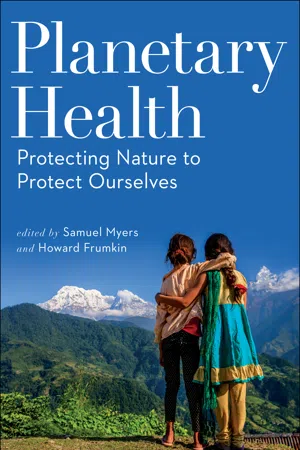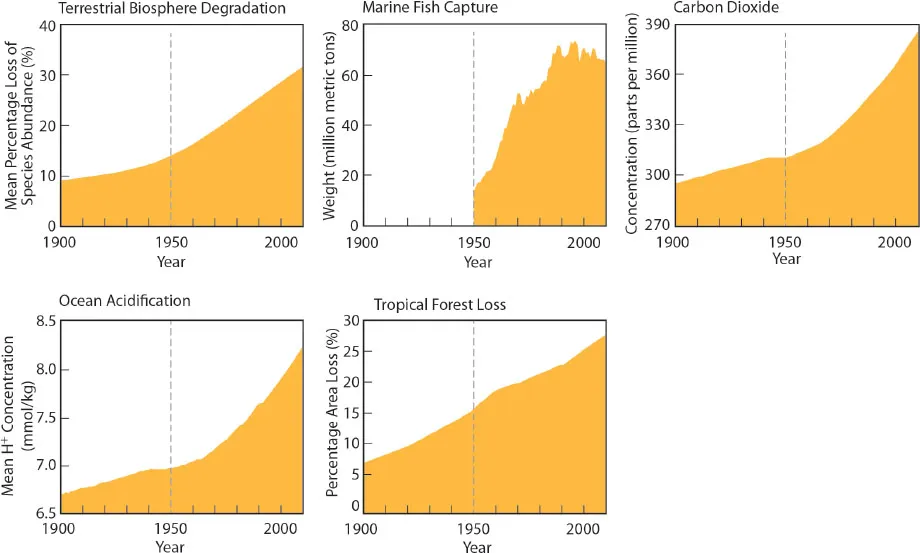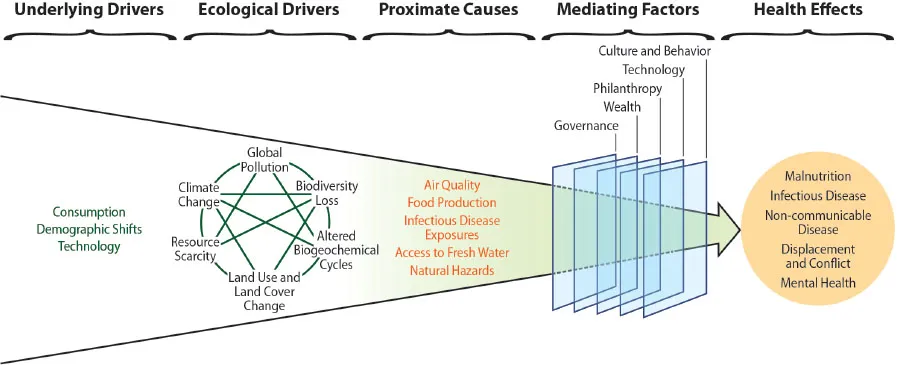
- 536 pages
- English
- ePUB (mobile friendly)
- Available on iOS & Android
eBook - ePub
About this book
Human health depends on the health of the planet. Earth's natural systems—the air, the water, the biodiversity, the climate—are our life support systems. Yet climate change, biodiversity loss, scarcity of land and freshwater, pollution and other threats are degrading these systems. The emerging field of planetary health aims to understand how these changes threaten our health and how to protect ourselves and the rest of the biosphere.
Planetary Health: Protecting Nature to Protect Ourselves provides a readable introduction to this new paradigm. With an interdisciplinary approach, the book addresses a wide range of health impacts felt in the Anthropocene, including food and nutrition, infectious disease, non-communicable disease, dislocation and conflict, and mental health. It also presents strategies to combat environmental changes and its ill-effects, such as controlling toxic exposures, investing in clean energy, improving urban design, and more. Chapters are authored by widely recognized experts.
The result is a comprehensive and optimistic overview of a growing field that is being adopted by researchers and universities around the world. Students of public health will gain a solid grounding in the new challenges their profession must confront, while those in the environmental sciences, agriculture, the design professions, and other fields will become familiar with the human consequences of planetary changes. Understanding how our changing environment affects our health is increasingly critical to a variety of disciplines and professions. Planetary Health is the definitive guide to this vital field.
Planetary Health: Protecting Nature to Protect Ourselves provides a readable introduction to this new paradigm. With an interdisciplinary approach, the book addresses a wide range of health impacts felt in the Anthropocene, including food and nutrition, infectious disease, non-communicable disease, dislocation and conflict, and mental health. It also presents strategies to combat environmental changes and its ill-effects, such as controlling toxic exposures, investing in clean energy, improving urban design, and more. Chapters are authored by widely recognized experts.
The result is a comprehensive and optimistic overview of a growing field that is being adopted by researchers and universities around the world. Students of public health will gain a solid grounding in the new challenges their profession must confront, while those in the environmental sciences, agriculture, the design professions, and other fields will become familiar with the human consequences of planetary changes. Understanding how our changing environment affects our health is increasingly critical to a variety of disciplines and professions. Planetary Health is the definitive guide to this vital field.
Frequently asked questions
Yes, you can cancel anytime from the Subscription tab in your account settings on the Perlego website. Your subscription will stay active until the end of your current billing period. Learn how to cancel your subscription.
No, books cannot be downloaded as external files, such as PDFs, for use outside of Perlego. However, you can download books within the Perlego app for offline reading on mobile or tablet. Learn more here.
Perlego offers two plans: Essential and Complete
- Essential is ideal for learners and professionals who enjoy exploring a wide range of subjects. Access the Essential Library with 800,000+ trusted titles and best-sellers across business, personal growth, and the humanities. Includes unlimited reading time and Standard Read Aloud voice.
- Complete: Perfect for advanced learners and researchers needing full, unrestricted access. Unlock 1.4M+ books across hundreds of subjects, including academic and specialized titles. The Complete Plan also includes advanced features like Premium Read Aloud and Research Assistant.
We are an online textbook subscription service, where you can get access to an entire online library for less than the price of a single book per month. With over 1 million books across 1000+ topics, we’ve got you covered! Learn more here.
Look out for the read-aloud symbol on your next book to see if you can listen to it. The read-aloud tool reads text aloud for you, highlighting the text as it is being read. You can pause it, speed it up and slow it down. Learn more here.
Yes! You can use the Perlego app on both iOS or Android devices to read anytime, anywhere — even offline. Perfect for commutes or when you’re on the go.
Please note we cannot support devices running on iOS 13 and Android 7 or earlier. Learn more about using the app.
Please note we cannot support devices running on iOS 13 and Android 7 or earlier. Learn more about using the app.
Yes, you can access Planetary Health by Samuel Myers,Howard Frumkin in PDF and/or ePUB format, as well as other popular books in Social Sciences & Environment & Energy Policy. We have over one million books available in our catalogue for you to explore.
Information
PART 1
Foundations
1
An Introduction to Planetary Health
Samuel Myers and Howard Frumkin
It was the best of times, it was the worst of times, it was the age of wisdom, it was the age of foolishness, . . it was the season of Light, it was the season of Darkness, it was the spring of hope, it was the winter of despair.
By many metrics, there has never been a better time to be a human being. Indeed, the past 70 years have seen almost unimaginable improvements in global human wellbeing. Between 1940 and 2015 the percentage of adults around the world who could read and write doubled, from 42% to 86%.1 In 1950, there were 1.6 billion people living in extreme poverty and 924 million people not in extreme poverty. By 2015, there were 733 million people living in extreme poverty and 6.6 billion people not living in extreme poverty.2 In other words, in 65 years the percentage of the world’s people living in extreme poverty dropped from 63% to 10% despite a near tripling of the global population. In 1950, global life expectancy was 46 years. Sixty-five years later, it was 72.3 And during that same period, child mortality dropped from 225 per 1,000 to 45 per 1,000 (Figure 1.1).4 These are unprecedented achievements in human history.
But there may never have been a worse time for the rest of the biosphere, at least since human beings began walking the planet. On March 17, 2019, a male Cuvier’s beaked whale washed up in the Philippines dead. It was still immature, and, wondering what could have killed such a magnificent creature capable of diving to depths of nearly 3,000 meters and normally living up to 60 years, scientists performed a necropsy. Inside the whale’s stomach and intestines, they found 88 pounds of plastic garbage. As of 2015, the inhabitants of 192 coastal countries are responsible for dumping roughly 8 million metric tons of plastic waste into the world’s oceans every year.5

Figure 1.1
Measures of human development over time reveal extraordinary improvements over the twentieth century in (a) literacy, (b) wealth, (c) child survival, and (d) life expectancy.
Sources:
Panel A: Our World in Data (https://ourworldindata.org/literacy), Creative Commons, license CC BY 4.0
Panel B: Our World in Data (https://ourworldindata.org/extreme-poverty), Creative Commons, license CC BY 4.0
Panel C: Our World in Data (https://ourworldindata.org/child-mortality), Creative Commons, license CC BY 4.0
Panel D: Our World in Data (https://ourworldindata.org/life-expectancy), Creative Commons, license CC BY 4.0
The same extraordinary scientific and technological developments that have pulled humanity out of poverty, increased our life expectancies, and driven unprecedented gains in human development in less than a lifetime are also fueling an extraordinary ballooning of humanity’s ecological footprint. The combination of rapid human population growth with even steeper increases in per capita consumption are driving nearly exponential growth in human production and consumption of everything from motor vehicles to synthetic fertilizers, paper, and plastic to water and energy use (Figure 1.2).

Figure 1.2
Metrics of consumption over time show very rapid intensification of global consumption from 1950 to the present across multiple categories including freshwater use, proliferation of motor vehicles, production and use of synthetic fertilizers, production of paper and plastics, and primary energy consumption.
Source: Myers SS. Planetary health: protecting human health on a rapidly changing planet. Lancet. 2017;390(10114):2860-2868.
Data originally collected by Steffen W, Broadgate W, Deutsch L, Gaffney O, Ludwig C. The trajectory of the Anthropocene: the great acceleration. Anthropocene Rev. 2015;2:81–98; except global plastic production from Geyer R, Jambeck JR, Law KL. Production, use, and fate of all plastics ever made. Sci Adv. 2017; 3: e1700782.
As a consequence of this explosion in human consumption, measures of our impacts across the planet’s natural systems—loss of biodiversity, exploitation of fisheries, rising carbon dioxide in the atmosphere, acidification of oceans, or loss of tropical forests—show similarly steep accelerations since the 1950s and 1960s (Figure 1.3).
The impacts of people on our planet’s natural systems are now immense. To feed ourselves, we have turned 40% of Earth’s land surface into croplands and pasture.6 We use about half the accessible fresh water on the planet, mostly to irrigate our crops,7 and we exploit 90% of monitored fisheries at or beyond maximum sustainable limits.8 We have cut down roughly half the world’s temperate and tropical forests6 and dammed more than 60% of the world’s rivers.9 And we are crowding out the rest of life on our planet. In May 2019, 145 authors from fifty countries released the Global Assessment of the Intergovernmental Panel on Biodiversity and Ecosystem Services. After reviewing 15,000 articles over 3 years, they concluded that roughly one million species are facing extinction, many within decades.10 Already, we have reduced the numbers of birds, mammals, reptiles, amphibians, and fishes who share the planet with us by more than 50% since 1970.11

Figure 1.3
Metrics of human impact on Earth’s natural systems show rapid intensification since 1950 including loss of biodiversity, exploitation of global fisheries, addition of carbon dioxide to the atmosphere, ocean acidification, and tropical deforestation.
Source: Myers SS. Planetary health: protecting human health on a rapidly changing planet. Lancet. 2017;390(10114):2860-2868.
Data originally collected by Steffen W, Broadgate W, Deutsch L, Gaffney O, Ludwig C. The trajectory of the Anthropocene: the great acceleration. Anthropocene Rev. 2015;2:81–98
These are, indeed, the best of times and the worst of times. But at the heart of the field of planetary health is recognition that the wellbeing of humanity and the degradation of the rest of the biosphere cannot remain disconnected for much longer. The scale of the human enterprise now surpasses our planet’s capacity to absorb our wastes or provide the resources we are using. Human activities are driving fundamental biophysical change at rates that are much steeper than have existed in the history of our species (see Figure 1.3). These biophysical changes are taking place across at least six dimensions: disruption of the global climate system; widespread pollution of air, water, and soils; rapid biodiversity loss; reconfiguration of biogeochemical cycles, including for carbon, nitrogen, and phosphorus; pervasive changes in land use and land cover; and depletion of resources including of fresh water and arable land. Each of these dimensions interacts with the others in complex ways, altering core conditions for human health: the quality of the air we breathe, the water we drink, and the food we can produce. Rapidly changing environmental conditions also alter our exposures to infectious diseases and natural hazards such as heat waves, droughts, floods, fires, and tropical storms. These changes in the conditions of our lives ultimately affect every dimension of our health and wellbeing, as illustrated in Figure 1.4. Planetary health focuses on understanding and quantifying the human health impacts of these global environmental disruptions and on developing solutions that will allow humanity and the natural systems we depend on to thrive now and in the future.

Figure 1.4
Schematic illustrating impacts of anthropogenic change on human health. Driven by rapid population growth, even steeper growth in per capita consumption, and technologies with large environmental impacts, the scale of human activity now outstrips our planet’s capacity to absorb our wastes or provide the resources we are using. As a result, we are transforming and disrupting most of our planet’s natural systems. Those disruptions interact with each other in complex ways to alter the fundamental conditions for human health and wellbeing and, ultimately, affect nearly every dimension of human health.
Source: Myers SS. Planetary health: protecting human health on a rapidly changing planet. Lancet. 2017;390(10114):2860-2868.
ORGANIZATION
The first part of this book follows the flow of Figure 1.4. After Chapter 2 presents a brief discussion of where planetary health comes from, its intellectual history, Chapter 3 addresses the critical roles of human population growth and rising per capita consumption as drivers of environmental change. Chapter 4 then explores how these drivers are transforming our planet’s environmental conditions across the dimensions outlined above. The next several chapters explore the many pathways through which those environmental disruptions jeopardize human health: nutrition, infectious disease exposure, noncommunicable disease, population displacement and conflict, and mental health. Next are chapters exploring two special topics: the health impacts of climate change, an emblematic challenge of the Anthropocene, and the phenomenon of happiness—a reminder that there is more to human wellbeing than biomedical health and that the broader view is highly relevant to planetary health. After laying out the health challenges we face, our book turns to the rich terrain of solutions. Chapters on the energy system, urban form, the chemical industry, economic theory, and the private sector explore what we consider pivotal issues: areas in which human activity has caused significant environmental damage but can also move humanity onto a sustainable trajectory. Chapter 17 explores the intersection of planetary health with ethics, and the final chapter describes an optimistic and aspirational future and outlines the steps we could take to get there. Occasionally, throughout these ch...
Table of contents
- Cover
- Title Page
- Copyright
- Dedication
- Contents
- List of Tables and Boxes
- Preface: A Note on Covid-19
- Acknowledgments
- Part 1: Foundations
- Part 2: The Health of Populations
- Part 3: Pivoting from Threat to Opportunity
- Part 4: Saving Ourselves, Saving Our Planet
- Afterword: Coronavirus and Planetary Health
- Index
- About the Editors